Employee Relations Report: Analyzing Employee Relations in the NHS
VerifiedAdded on 2020/01/23
|12
|4226
|148
Report
AI Summary
This report delves into the intricacies of employee relations, specifically within the context of the NHS. It begins by outlining the unitary and pluralistic approaches to employee relations, highlighting their implications for conflict resolution. The report then analyzes key factors influencing employee relations in the NHS, including the roles of workers, managers, and the organization itself. It further examines the impact of trade unions and the influence of the European Union on industrial democracy in the UK. The report addresses a specific conflict scenario involving junior doctors, the government, and the British Medical Association, detailing the procedures the NHS should follow in such situations and identifying the key features of employee relations at play. Finally, the report explores the role of negotiation in collective bargaining and the impact of negotiation strategies employed by the involved parties.
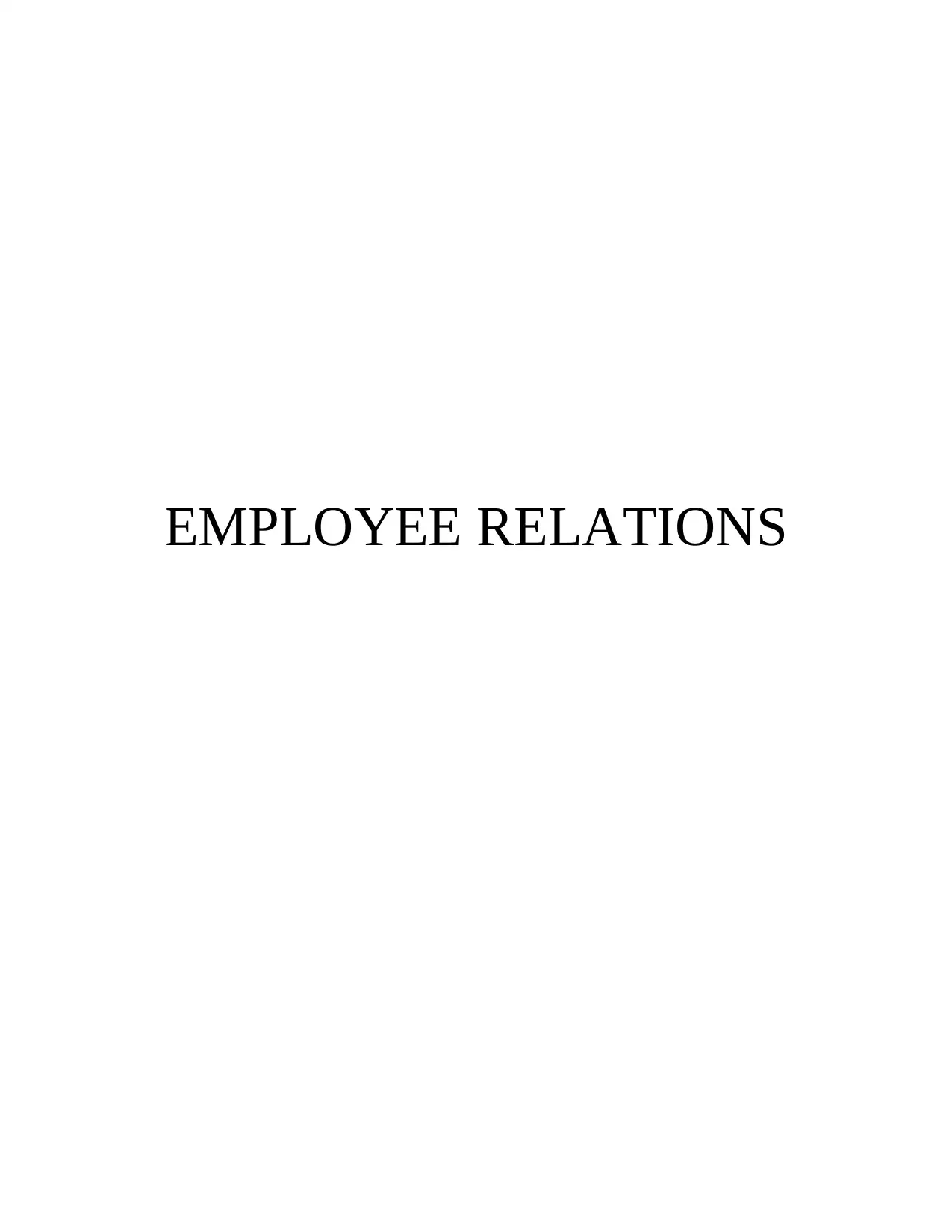
EMPLOYEE RELATIONS
Paraphrase This Document
Need a fresh take? Get an instant paraphrase of this document with our AI Paraphraser
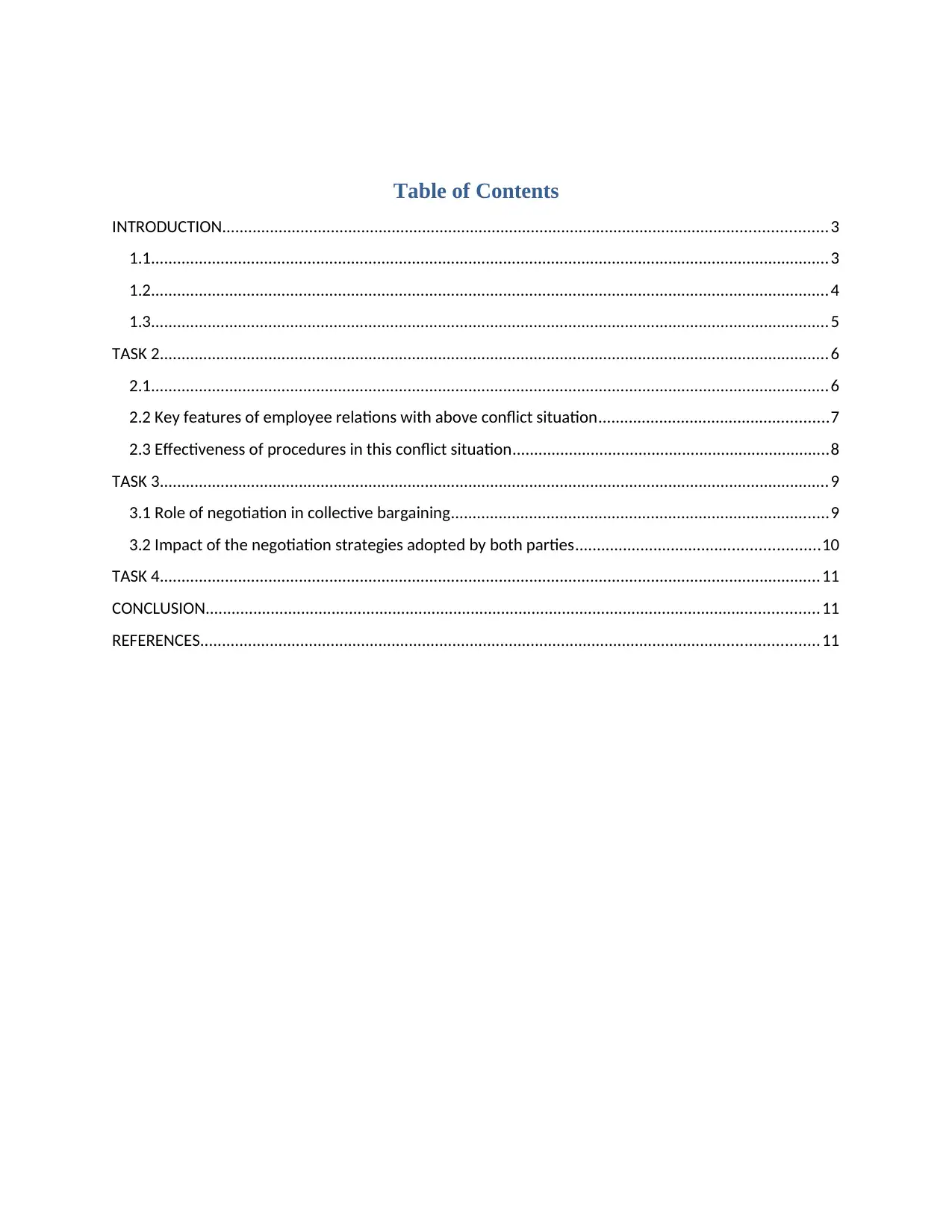
Table of Contents
INTRODUCTION...........................................................................................................................................3
1.1............................................................................................................................................................3
1.2............................................................................................................................................................4
1.3............................................................................................................................................................5
TASK 2..........................................................................................................................................................6
2.1............................................................................................................................................................6
2.2 Key features of employee relations with above conflict situation.....................................................7
2.3 Effectiveness of procedures in this conflict situation.........................................................................8
TASK 3..........................................................................................................................................................9
3.1 Role of negotiation in collective bargaining.......................................................................................9
3.2 Impact of the negotiation strategies adopted by both parties........................................................10
TASK 4........................................................................................................................................................11
CONCLUSION.............................................................................................................................................11
REFERENCES..............................................................................................................................................11
INTRODUCTION...........................................................................................................................................3
1.1............................................................................................................................................................3
1.2............................................................................................................................................................4
1.3............................................................................................................................................................5
TASK 2..........................................................................................................................................................6
2.1............................................................................................................................................................6
2.2 Key features of employee relations with above conflict situation.....................................................7
2.3 Effectiveness of procedures in this conflict situation.........................................................................8
TASK 3..........................................................................................................................................................9
3.1 Role of negotiation in collective bargaining.......................................................................................9
3.2 Impact of the negotiation strategies adopted by both parties........................................................10
TASK 4........................................................................................................................................................11
CONCLUSION.............................................................................................................................................11
REFERENCES..............................................................................................................................................11
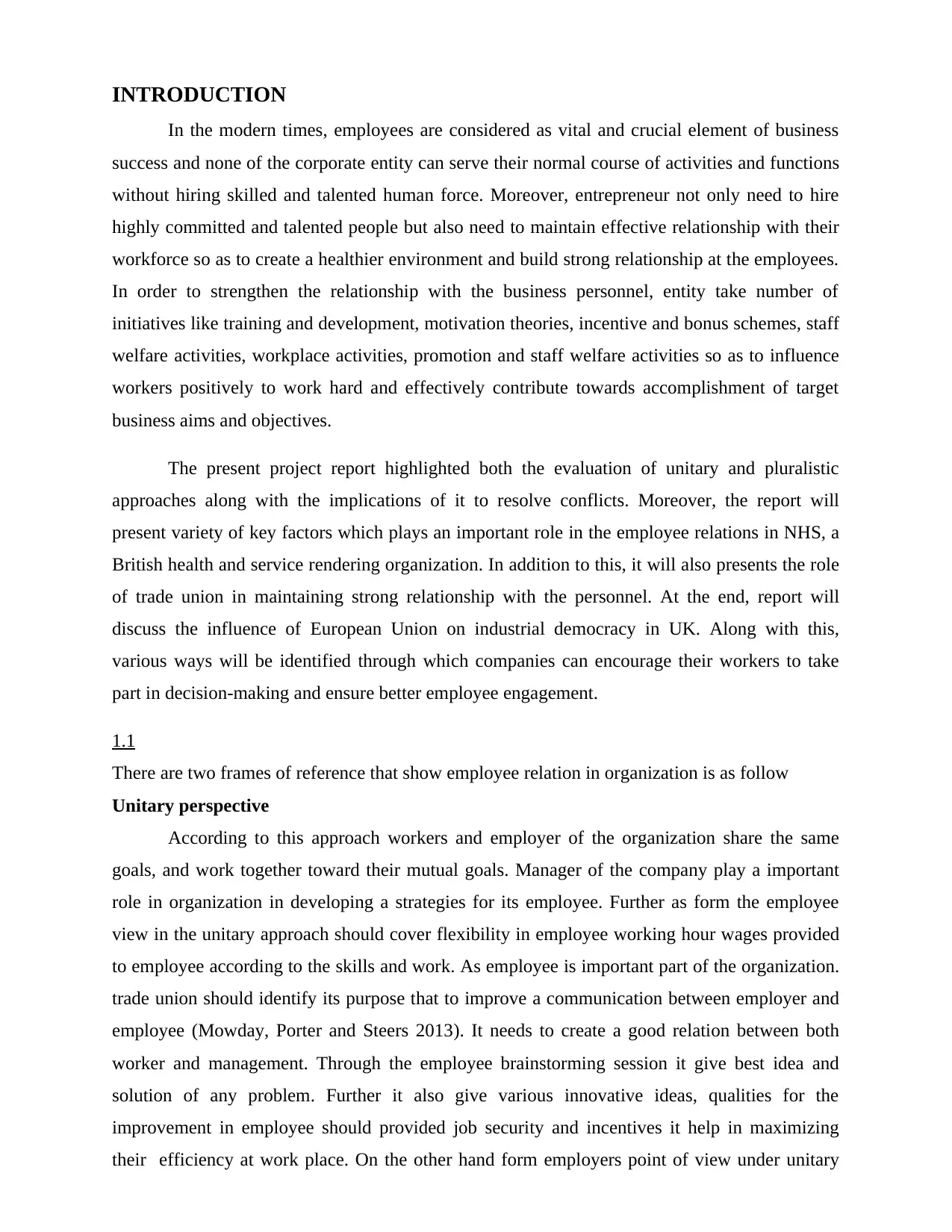
INTRODUCTION
In the modern times, employees are considered as vital and crucial element of business
success and none of the corporate entity can serve their normal course of activities and functions
without hiring skilled and talented human force. Moreover, entrepreneur not only need to hire
highly committed and talented people but also need to maintain effective relationship with their
workforce so as to create a healthier environment and build strong relationship at the employees.
In order to strengthen the relationship with the business personnel, entity take number of
initiatives like training and development, motivation theories, incentive and bonus schemes, staff
welfare activities, workplace activities, promotion and staff welfare activities so as to influence
workers positively to work hard and effectively contribute towards accomplishment of target
business aims and objectives.
The present project report highlighted both the evaluation of unitary and pluralistic
approaches along with the implications of it to resolve conflicts. Moreover, the report will
present variety of key factors which plays an important role in the employee relations in NHS, a
British health and service rendering organization. In addition to this, it will also presents the role
of trade union in maintaining strong relationship with the personnel. At the end, report will
discuss the influence of European Union on industrial democracy in UK. Along with this,
various ways will be identified through which companies can encourage their workers to take
part in decision-making and ensure better employee engagement.
1.1
There are two frames of reference that show employee relation in organization is as follow
Unitary perspective
According to this approach workers and employer of the organization share the same
goals, and work together toward their mutual goals. Manager of the company play a important
role in organization in developing a strategies for its employee. Further as form the employee
view in the unitary approach should cover flexibility in employee working hour wages provided
to employee according to the skills and work. As employee is important part of the organization.
trade union should identify its purpose that to improve a communication between employer and
employee (Mowday, Porter and Steers 2013). It needs to create a good relation between both
worker and management. Through the employee brainstorming session it give best idea and
solution of any problem. Further it also give various innovative ideas, qualities for the
improvement in employee should provided job security and incentives it help in maximizing
their efficiency at work place. On the other hand form employers point of view under unitary
In the modern times, employees are considered as vital and crucial element of business
success and none of the corporate entity can serve their normal course of activities and functions
without hiring skilled and talented human force. Moreover, entrepreneur not only need to hire
highly committed and talented people but also need to maintain effective relationship with their
workforce so as to create a healthier environment and build strong relationship at the employees.
In order to strengthen the relationship with the business personnel, entity take number of
initiatives like training and development, motivation theories, incentive and bonus schemes, staff
welfare activities, workplace activities, promotion and staff welfare activities so as to influence
workers positively to work hard and effectively contribute towards accomplishment of target
business aims and objectives.
The present project report highlighted both the evaluation of unitary and pluralistic
approaches along with the implications of it to resolve conflicts. Moreover, the report will
present variety of key factors which plays an important role in the employee relations in NHS, a
British health and service rendering organization. In addition to this, it will also presents the role
of trade union in maintaining strong relationship with the personnel. At the end, report will
discuss the influence of European Union on industrial democracy in UK. Along with this,
various ways will be identified through which companies can encourage their workers to take
part in decision-making and ensure better employee engagement.
1.1
There are two frames of reference that show employee relation in organization is as follow
Unitary perspective
According to this approach workers and employer of the organization share the same
goals, and work together toward their mutual goals. Manager of the company play a important
role in organization in developing a strategies for its employee. Further as form the employee
view in the unitary approach should cover flexibility in employee working hour wages provided
to employee according to the skills and work. As employee is important part of the organization.
trade union should identify its purpose that to improve a communication between employer and
employee (Mowday, Porter and Steers 2013). It needs to create a good relation between both
worker and management. Through the employee brainstorming session it give best idea and
solution of any problem. Further it also give various innovative ideas, qualities for the
improvement in employee should provided job security and incentives it help in maximizing
their efficiency at work place. On the other hand form employers point of view under unitary
⊘ This is a preview!⊘
Do you want full access?
Subscribe today to unlock all pages.

Trusted by 1+ million students worldwide
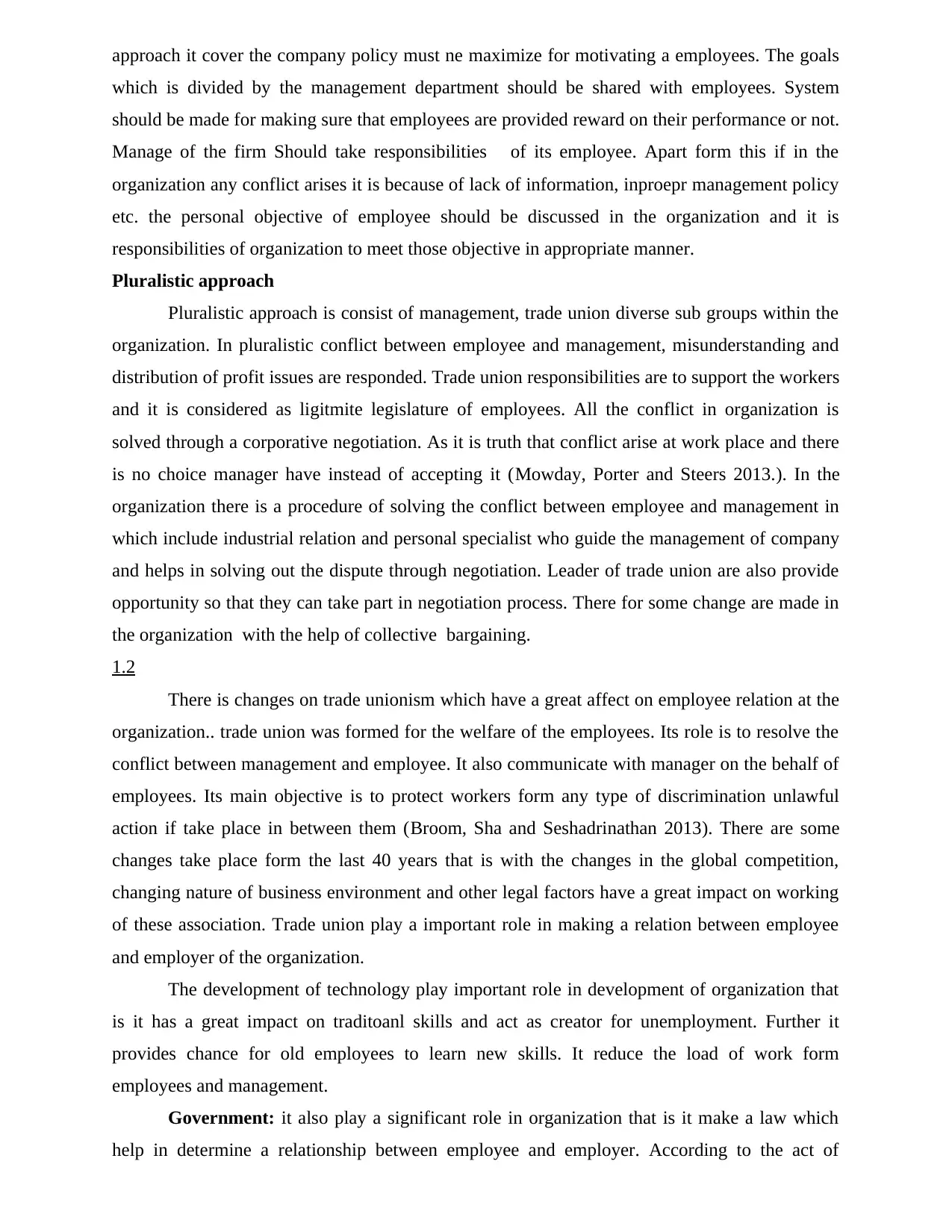
approach it cover the company policy must ne maximize for motivating a employees. The goals
which is divided by the management department should be shared with employees. System
should be made for making sure that employees are provided reward on their performance or not.
Manage of the firm Should take responsibilities of its employee. Apart form this if in the
organization any conflict arises it is because of lack of information, inproepr management policy
etc. the personal objective of employee should be discussed in the organization and it is
responsibilities of organization to meet those objective in appropriate manner.
Pluralistic approach
Pluralistic approach is consist of management, trade union diverse sub groups within the
organization. In pluralistic conflict between employee and management, misunderstanding and
distribution of profit issues are responded. Trade union responsibilities are to support the workers
and it is considered as ligitmite legislature of employees. All the conflict in organization is
solved through a corporative negotiation. As it is truth that conflict arise at work place and there
is no choice manager have instead of accepting it (Mowday, Porter and Steers 2013.). In the
organization there is a procedure of solving the conflict between employee and management in
which include industrial relation and personal specialist who guide the management of company
and helps in solving out the dispute through negotiation. Leader of trade union are also provide
opportunity so that they can take part in negotiation process. There for some change are made in
the organization with the help of collective bargaining.
1.2
There is changes on trade unionism which have a great affect on employee relation at the
organization.. trade union was formed for the welfare of the employees. Its role is to resolve the
conflict between management and employee. It also communicate with manager on the behalf of
employees. Its main objective is to protect workers form any type of discrimination unlawful
action if take place in between them (Broom, Sha and Seshadrinathan 2013). There are some
changes take place form the last 40 years that is with the changes in the global competition,
changing nature of business environment and other legal factors have a great impact on working
of these association. Trade union play a important role in making a relation between employee
and employer of the organization.
The development of technology play important role in development of organization that
is it has a great impact on traditoanl skills and act as creator for unemployment. Further it
provides chance for old employees to learn new skills. It reduce the load of work form
employees and management.
Government: it also play a significant role in organization that is it make a law which
help in determine a relationship between employee and employer. According to the act of
which is divided by the management department should be shared with employees. System
should be made for making sure that employees are provided reward on their performance or not.
Manage of the firm Should take responsibilities of its employee. Apart form this if in the
organization any conflict arises it is because of lack of information, inproepr management policy
etc. the personal objective of employee should be discussed in the organization and it is
responsibilities of organization to meet those objective in appropriate manner.
Pluralistic approach
Pluralistic approach is consist of management, trade union diverse sub groups within the
organization. In pluralistic conflict between employee and management, misunderstanding and
distribution of profit issues are responded. Trade union responsibilities are to support the workers
and it is considered as ligitmite legislature of employees. All the conflict in organization is
solved through a corporative negotiation. As it is truth that conflict arise at work place and there
is no choice manager have instead of accepting it (Mowday, Porter and Steers 2013.). In the
organization there is a procedure of solving the conflict between employee and management in
which include industrial relation and personal specialist who guide the management of company
and helps in solving out the dispute through negotiation. Leader of trade union are also provide
opportunity so that they can take part in negotiation process. There for some change are made in
the organization with the help of collective bargaining.
1.2
There is changes on trade unionism which have a great affect on employee relation at the
organization.. trade union was formed for the welfare of the employees. Its role is to resolve the
conflict between management and employee. It also communicate with manager on the behalf of
employees. Its main objective is to protect workers form any type of discrimination unlawful
action if take place in between them (Broom, Sha and Seshadrinathan 2013). There are some
changes take place form the last 40 years that is with the changes in the global competition,
changing nature of business environment and other legal factors have a great impact on working
of these association. Trade union play a important role in making a relation between employee
and employer of the organization.
The development of technology play important role in development of organization that
is it has a great impact on traditoanl skills and act as creator for unemployment. Further it
provides chance for old employees to learn new skills. It reduce the load of work form
employees and management.
Government: it also play a significant role in organization that is it make a law which
help in determine a relationship between employee and employer. According to the act of
Paraphrase This Document
Need a fresh take? Get an instant paraphrase of this document with our AI Paraphraser
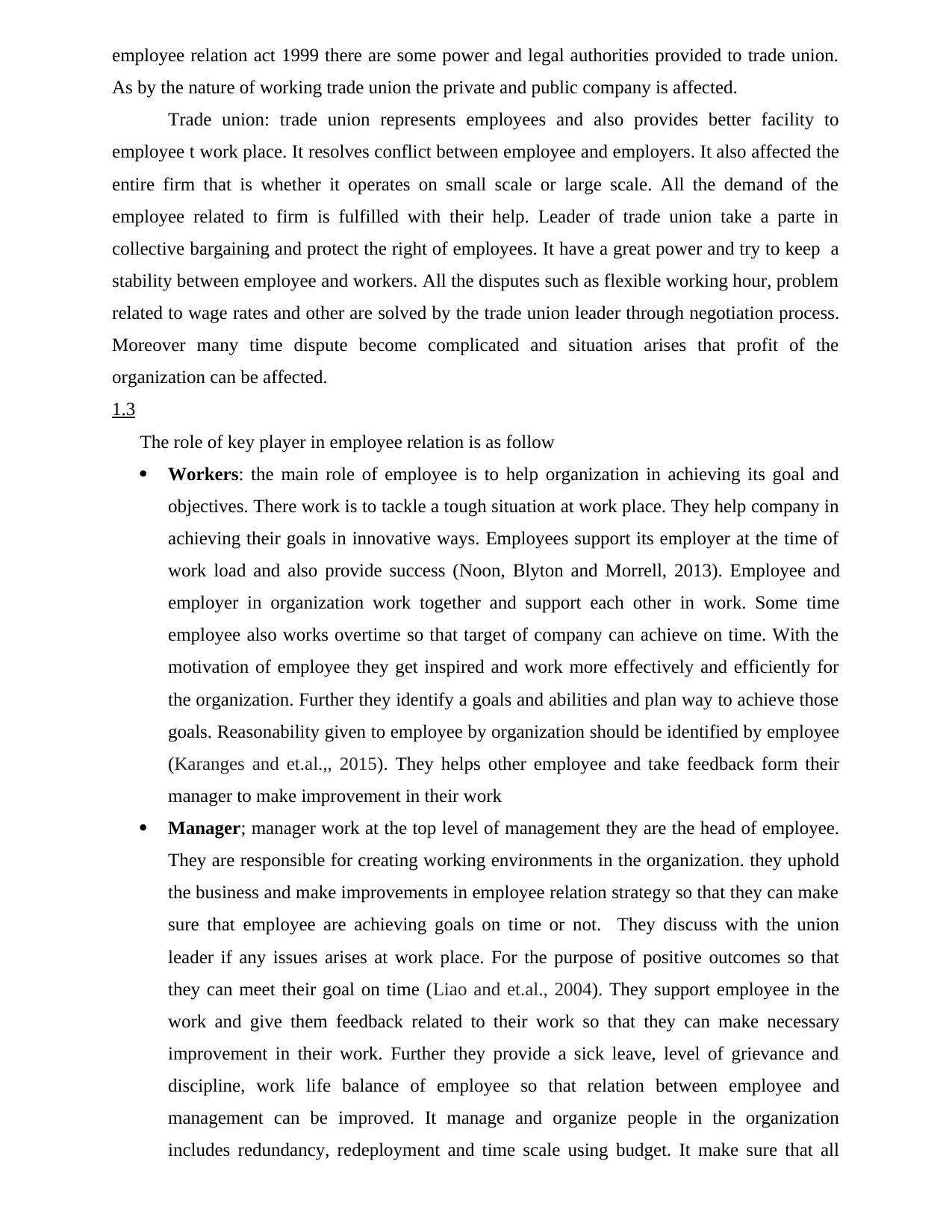
employee relation act 1999 there are some power and legal authorities provided to trade union.
As by the nature of working trade union the private and public company is affected.
Trade union: trade union represents employees and also provides better facility to
employee t work place. It resolves conflict between employee and employers. It also affected the
entire firm that is whether it operates on small scale or large scale. All the demand of the
employee related to firm is fulfilled with their help. Leader of trade union take a parte in
collective bargaining and protect the right of employees. It have a great power and try to keep a
stability between employee and workers. All the disputes such as flexible working hour, problem
related to wage rates and other are solved by the trade union leader through negotiation process.
Moreover many time dispute become complicated and situation arises that profit of the
organization can be affected.
1.3
The role of key player in employee relation is as follow
Workers: the main role of employee is to help organization in achieving its goal and
objectives. There work is to tackle a tough situation at work place. They help company in
achieving their goals in innovative ways. Employees support its employer at the time of
work load and also provide success (Noon, Blyton and Morrell, 2013). Employee and
employer in organization work together and support each other in work. Some time
employee also works overtime so that target of company can achieve on time. With the
motivation of employee they get inspired and work more effectively and efficiently for
the organization. Further they identify a goals and abilities and plan way to achieve those
goals. Reasonability given to employee by organization should be identified by employee
(Karanges and et.al.,, 2015). They helps other employee and take feedback form their
manager to make improvement in their work
Manager; manager work at the top level of management they are the head of employee.
They are responsible for creating working environments in the organization. they uphold
the business and make improvements in employee relation strategy so that they can make
sure that employee are achieving goals on time or not. They discuss with the union
leader if any issues arises at work place. For the purpose of positive outcomes so that
they can meet their goal on time (Liao and et.al., 2004). They support employee in the
work and give them feedback related to their work so that they can make necessary
improvement in their work. Further they provide a sick leave, level of grievance and
discipline, work life balance of employee so that relation between employee and
management can be improved. It manage and organize people in the organization
includes redundancy, redeployment and time scale using budget. It make sure that all
As by the nature of working trade union the private and public company is affected.
Trade union: trade union represents employees and also provides better facility to
employee t work place. It resolves conflict between employee and employers. It also affected the
entire firm that is whether it operates on small scale or large scale. All the demand of the
employee related to firm is fulfilled with their help. Leader of trade union take a parte in
collective bargaining and protect the right of employees. It have a great power and try to keep a
stability between employee and workers. All the disputes such as flexible working hour, problem
related to wage rates and other are solved by the trade union leader through negotiation process.
Moreover many time dispute become complicated and situation arises that profit of the
organization can be affected.
1.3
The role of key player in employee relation is as follow
Workers: the main role of employee is to help organization in achieving its goal and
objectives. There work is to tackle a tough situation at work place. They help company in
achieving their goals in innovative ways. Employees support its employer at the time of
work load and also provide success (Noon, Blyton and Morrell, 2013). Employee and
employer in organization work together and support each other in work. Some time
employee also works overtime so that target of company can achieve on time. With the
motivation of employee they get inspired and work more effectively and efficiently for
the organization. Further they identify a goals and abilities and plan way to achieve those
goals. Reasonability given to employee by organization should be identified by employee
(Karanges and et.al.,, 2015). They helps other employee and take feedback form their
manager to make improvement in their work
Manager; manager work at the top level of management they are the head of employee.
They are responsible for creating working environments in the organization. they uphold
the business and make improvements in employee relation strategy so that they can make
sure that employee are achieving goals on time or not. They discuss with the union
leader if any issues arises at work place. For the purpose of positive outcomes so that
they can meet their goal on time (Liao and et.al., 2004). They support employee in the
work and give them feedback related to their work so that they can make necessary
improvement in their work. Further they provide a sick leave, level of grievance and
discipline, work life balance of employee so that relation between employee and
management can be improved. It manage and organize people in the organization
includes redundancy, redeployment and time scale using budget. It make sure that all
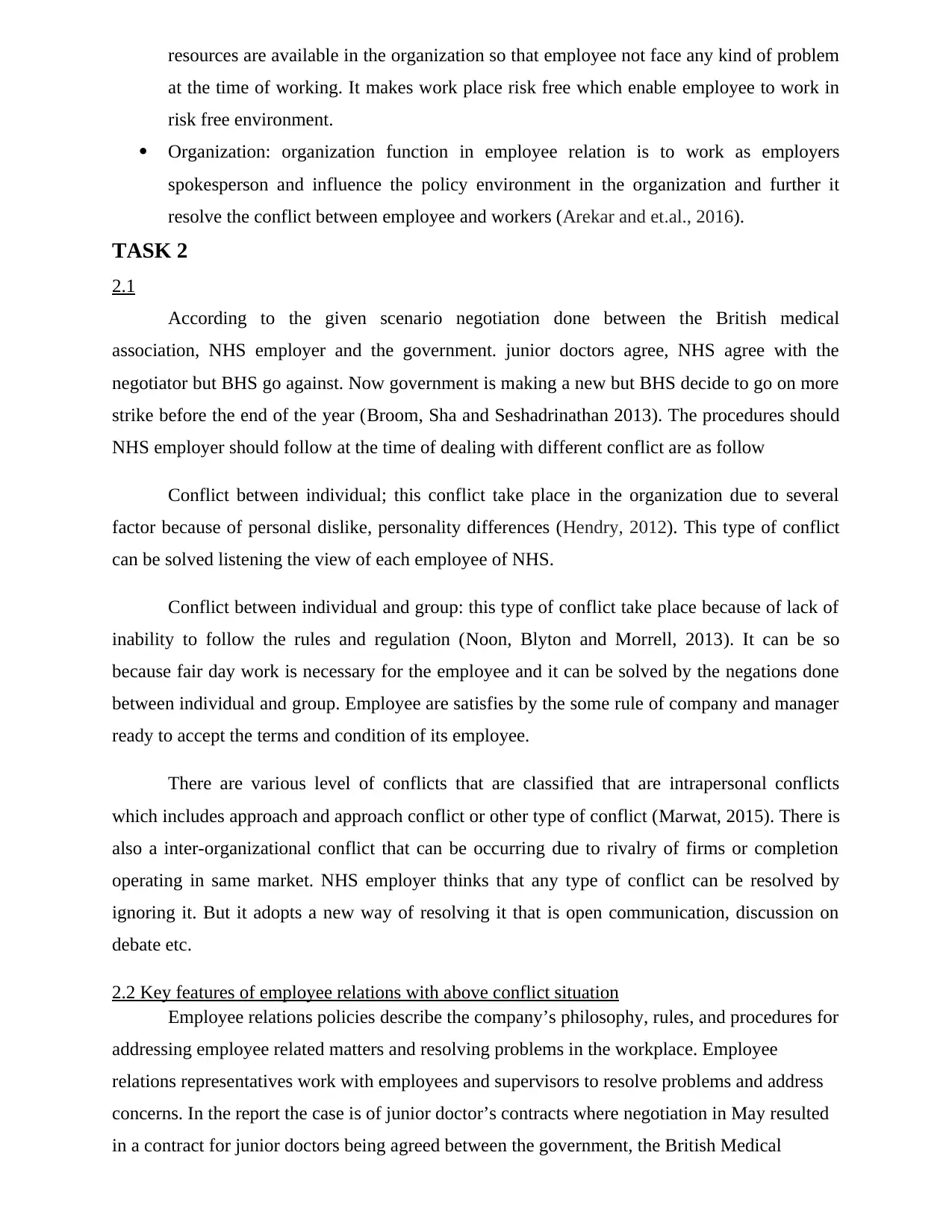
resources are available in the organization so that employee not face any kind of problem
at the time of working. It makes work place risk free which enable employee to work in
risk free environment.
Organization: organization function in employee relation is to work as employers
spokesperson and influence the policy environment in the organization and further it
resolve the conflict between employee and workers (Arekar and et.al., 2016).
TASK 2
2.1
According to the given scenario negotiation done between the British medical
association, NHS employer and the government. junior doctors agree, NHS agree with the
negotiator but BHS go against. Now government is making a new but BHS decide to go on more
strike before the end of the year (Broom, Sha and Seshadrinathan 2013). The procedures should
NHS employer should follow at the time of dealing with different conflict are as follow
Conflict between individual; this conflict take place in the organization due to several
factor because of personal dislike, personality differences (Hendry, 2012). This type of conflict
can be solved listening the view of each employee of NHS.
Conflict between individual and group: this type of conflict take place because of lack of
inability to follow the rules and regulation (Noon, Blyton and Morrell, 2013). It can be so
because fair day work is necessary for the employee and it can be solved by the negations done
between individual and group. Employee are satisfies by the some rule of company and manager
ready to accept the terms and condition of its employee.
There are various level of conflicts that are classified that are intrapersonal conflicts
which includes approach and approach conflict or other type of conflict (Marwat, 2015). There is
also a inter-organizational conflict that can be occurring due to rivalry of firms or completion
operating in same market. NHS employer thinks that any type of conflict can be resolved by
ignoring it. But it adopts a new way of resolving it that is open communication, discussion on
debate etc.
2.2 Key features of employee relations with above conflict situation
Employee relations policies describe the company’s philosophy, rules, and procedures for
addressing employee related matters and resolving problems in the workplace. Employee
relations representatives work with employees and supervisors to resolve problems and address
concerns. In the report the case is of junior doctor’s contracts where negotiation in May resulted
in a contract for junior doctors being agreed between the government, the British Medical
at the time of working. It makes work place risk free which enable employee to work in
risk free environment.
Organization: organization function in employee relation is to work as employers
spokesperson and influence the policy environment in the organization and further it
resolve the conflict between employee and workers (Arekar and et.al., 2016).
TASK 2
2.1
According to the given scenario negotiation done between the British medical
association, NHS employer and the government. junior doctors agree, NHS agree with the
negotiator but BHS go against. Now government is making a new but BHS decide to go on more
strike before the end of the year (Broom, Sha and Seshadrinathan 2013). The procedures should
NHS employer should follow at the time of dealing with different conflict are as follow
Conflict between individual; this conflict take place in the organization due to several
factor because of personal dislike, personality differences (Hendry, 2012). This type of conflict
can be solved listening the view of each employee of NHS.
Conflict between individual and group: this type of conflict take place because of lack of
inability to follow the rules and regulation (Noon, Blyton and Morrell, 2013). It can be so
because fair day work is necessary for the employee and it can be solved by the negations done
between individual and group. Employee are satisfies by the some rule of company and manager
ready to accept the terms and condition of its employee.
There are various level of conflicts that are classified that are intrapersonal conflicts
which includes approach and approach conflict or other type of conflict (Marwat, 2015). There is
also a inter-organizational conflict that can be occurring due to rivalry of firms or completion
operating in same market. NHS employer thinks that any type of conflict can be resolved by
ignoring it. But it adopts a new way of resolving it that is open communication, discussion on
debate etc.
2.2 Key features of employee relations with above conflict situation
Employee relations policies describe the company’s philosophy, rules, and procedures for
addressing employee related matters and resolving problems in the workplace. Employee
relations representatives work with employees and supervisors to resolve problems and address
concerns. In the report the case is of junior doctor’s contracts where negotiation in May resulted
in a contract for junior doctors being agreed between the government, the British Medical
⊘ This is a preview!⊘
Do you want full access?
Subscribe today to unlock all pages.

Trusted by 1+ million students worldwide
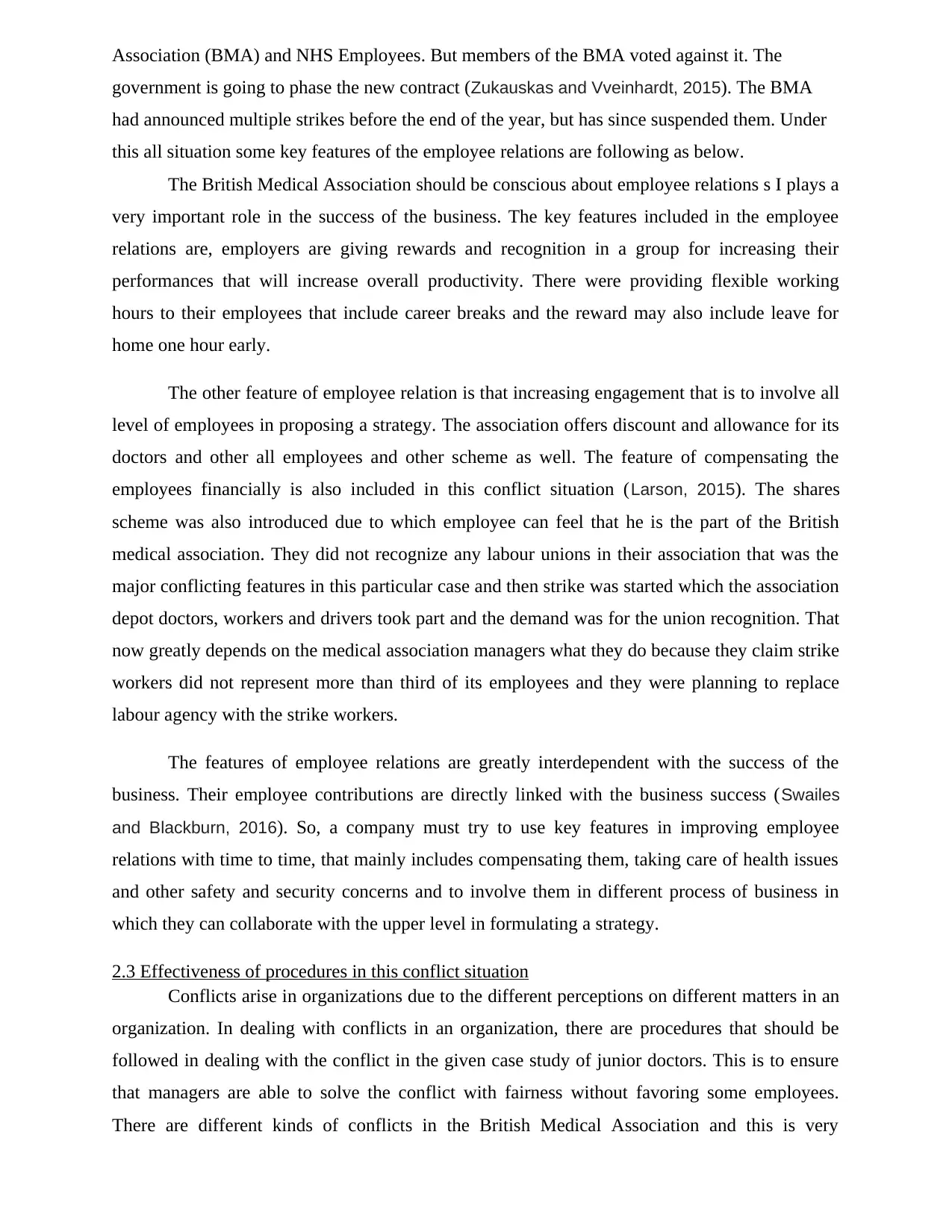
Association (BMA) and NHS Employees. But members of the BMA voted against it. The
government is going to phase the new contract (Zukauskas and Vveinhardt, 2015). The BMA
had announced multiple strikes before the end of the year, but has since suspended them. Under
this all situation some key features of the employee relations are following as below.
The British Medical Association should be conscious about employee relations s I plays a
very important role in the success of the business. The key features included in the employee
relations are, employers are giving rewards and recognition in a group for increasing their
performances that will increase overall productivity. There were providing flexible working
hours to their employees that include career breaks and the reward may also include leave for
home one hour early.
The other feature of employee relation is that increasing engagement that is to involve all
level of employees in proposing a strategy. The association offers discount and allowance for its
doctors and other all employees and other scheme as well. The feature of compensating the
employees financially is also included in this conflict situation (Larson, 2015). The shares
scheme was also introduced due to which employee can feel that he is the part of the British
medical association. They did not recognize any labour unions in their association that was the
major conflicting features in this particular case and then strike was started which the association
depot doctors, workers and drivers took part and the demand was for the union recognition. That
now greatly depends on the medical association managers what they do because they claim strike
workers did not represent more than third of its employees and they were planning to replace
labour agency with the strike workers.
The features of employee relations are greatly interdependent with the success of the
business. Their employee contributions are directly linked with the business success (Swailes
and Blackburn, 2016). So, a company must try to use key features in improving employee
relations with time to time, that mainly includes compensating them, taking care of health issues
and other safety and security concerns and to involve them in different process of business in
which they can collaborate with the upper level in formulating a strategy.
2.3 Effectiveness of procedures in this conflict situation
Conflicts arise in organizations due to the different perceptions on different matters in an
organization. In dealing with conflicts in an organization, there are procedures that should be
followed in dealing with the conflict in the given case study of junior doctors. This is to ensure
that managers are able to solve the conflict with fairness without favoring some employees.
There are different kinds of conflicts in the British Medical Association and this is very
government is going to phase the new contract (Zukauskas and Vveinhardt, 2015). The BMA
had announced multiple strikes before the end of the year, but has since suspended them. Under
this all situation some key features of the employee relations are following as below.
The British Medical Association should be conscious about employee relations s I plays a
very important role in the success of the business. The key features included in the employee
relations are, employers are giving rewards and recognition in a group for increasing their
performances that will increase overall productivity. There were providing flexible working
hours to their employees that include career breaks and the reward may also include leave for
home one hour early.
The other feature of employee relation is that increasing engagement that is to involve all
level of employees in proposing a strategy. The association offers discount and allowance for its
doctors and other all employees and other scheme as well. The feature of compensating the
employees financially is also included in this conflict situation (Larson, 2015). The shares
scheme was also introduced due to which employee can feel that he is the part of the British
medical association. They did not recognize any labour unions in their association that was the
major conflicting features in this particular case and then strike was started which the association
depot doctors, workers and drivers took part and the demand was for the union recognition. That
now greatly depends on the medical association managers what they do because they claim strike
workers did not represent more than third of its employees and they were planning to replace
labour agency with the strike workers.
The features of employee relations are greatly interdependent with the success of the
business. Their employee contributions are directly linked with the business success (Swailes
and Blackburn, 2016). So, a company must try to use key features in improving employee
relations with time to time, that mainly includes compensating them, taking care of health issues
and other safety and security concerns and to involve them in different process of business in
which they can collaborate with the upper level in formulating a strategy.
2.3 Effectiveness of procedures in this conflict situation
Conflicts arise in organizations due to the different perceptions on different matters in an
organization. In dealing with conflicts in an organization, there are procedures that should be
followed in dealing with the conflict in the given case study of junior doctors. This is to ensure
that managers are able to solve the conflict with fairness without favoring some employees.
There are different kinds of conflicts in the British Medical Association and this is very
Paraphrase This Document
Need a fresh take? Get an instant paraphrase of this document with our AI Paraphraser
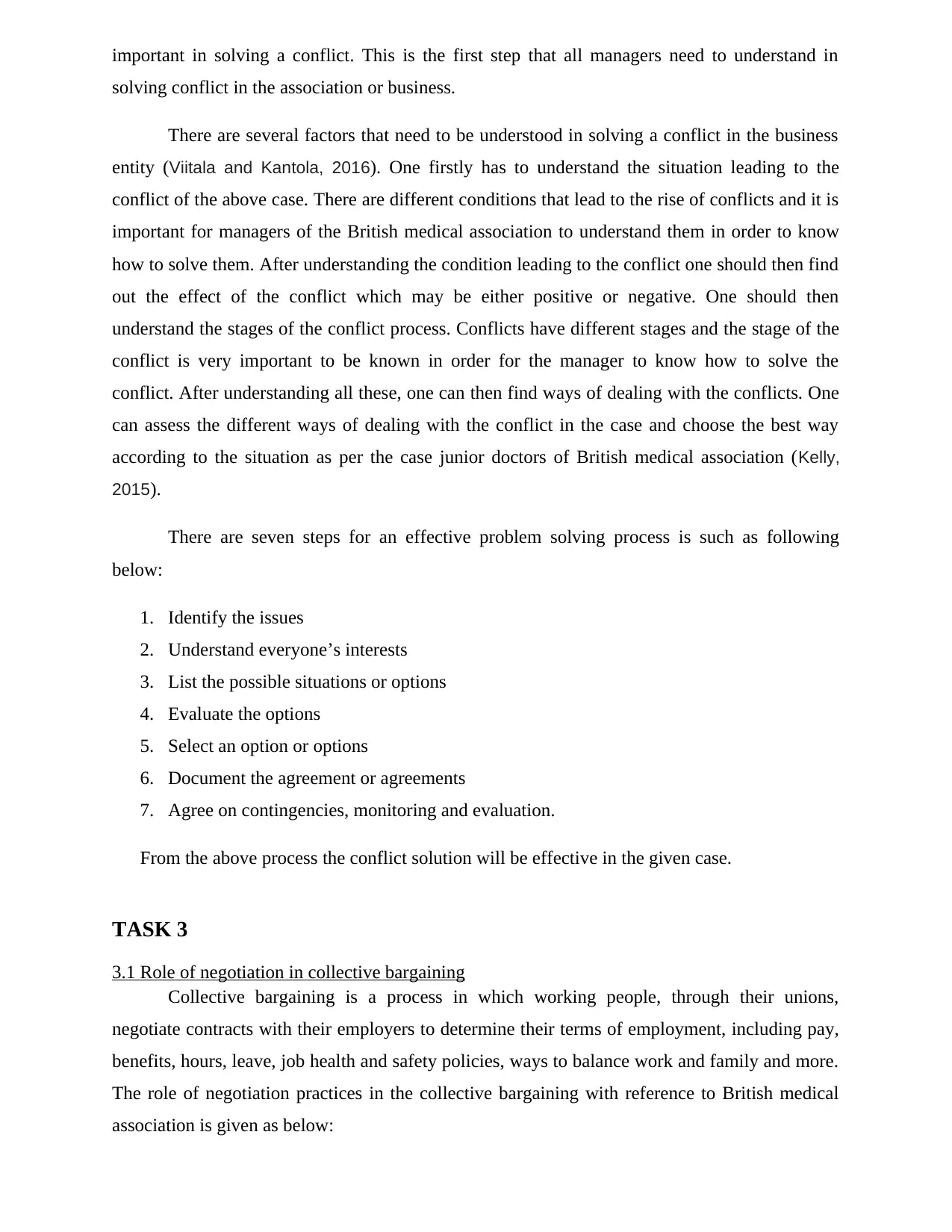
important in solving a conflict. This is the first step that all managers need to understand in
solving conflict in the association or business.
There are several factors that need to be understood in solving a conflict in the business
entity (Viitala and Kantola, 2016). One firstly has to understand the situation leading to the
conflict of the above case. There are different conditions that lead to the rise of conflicts and it is
important for managers of the British medical association to understand them in order to know
how to solve them. After understanding the condition leading to the conflict one should then find
out the effect of the conflict which may be either positive or negative. One should then
understand the stages of the conflict process. Conflicts have different stages and the stage of the
conflict is very important to be known in order for the manager to know how to solve the
conflict. After understanding all these, one can then find ways of dealing with the conflicts. One
can assess the different ways of dealing with the conflict in the case and choose the best way
according to the situation as per the case junior doctors of British medical association (Kelly,
2015).
There are seven steps for an effective problem solving process is such as following
below:
1. Identify the issues
2. Understand everyone’s interests
3. List the possible situations or options
4. Evaluate the options
5. Select an option or options
6. Document the agreement or agreements
7. Agree on contingencies, monitoring and evaluation.
From the above process the conflict solution will be effective in the given case.
TASK 3
3.1 Role of negotiation in collective bargaining
Collective bargaining is a process in which working people, through their unions,
negotiate contracts with their employers to determine their terms of employment, including pay,
benefits, hours, leave, job health and safety policies, ways to balance work and family and more.
The role of negotiation practices in the collective bargaining with reference to British medical
association is given as below:
solving conflict in the association or business.
There are several factors that need to be understood in solving a conflict in the business
entity (Viitala and Kantola, 2016). One firstly has to understand the situation leading to the
conflict of the above case. There are different conditions that lead to the rise of conflicts and it is
important for managers of the British medical association to understand them in order to know
how to solve them. After understanding the condition leading to the conflict one should then find
out the effect of the conflict which may be either positive or negative. One should then
understand the stages of the conflict process. Conflicts have different stages and the stage of the
conflict is very important to be known in order for the manager to know how to solve the
conflict. After understanding all these, one can then find ways of dealing with the conflicts. One
can assess the different ways of dealing with the conflict in the case and choose the best way
according to the situation as per the case junior doctors of British medical association (Kelly,
2015).
There are seven steps for an effective problem solving process is such as following
below:
1. Identify the issues
2. Understand everyone’s interests
3. List the possible situations or options
4. Evaluate the options
5. Select an option or options
6. Document the agreement or agreements
7. Agree on contingencies, monitoring and evaluation.
From the above process the conflict solution will be effective in the given case.
TASK 3
3.1 Role of negotiation in collective bargaining
Collective bargaining is a process in which working people, through their unions,
negotiate contracts with their employers to determine their terms of employment, including pay,
benefits, hours, leave, job health and safety policies, ways to balance work and family and more.
The role of negotiation practices in the collective bargaining with reference to British medical
association is given as below:
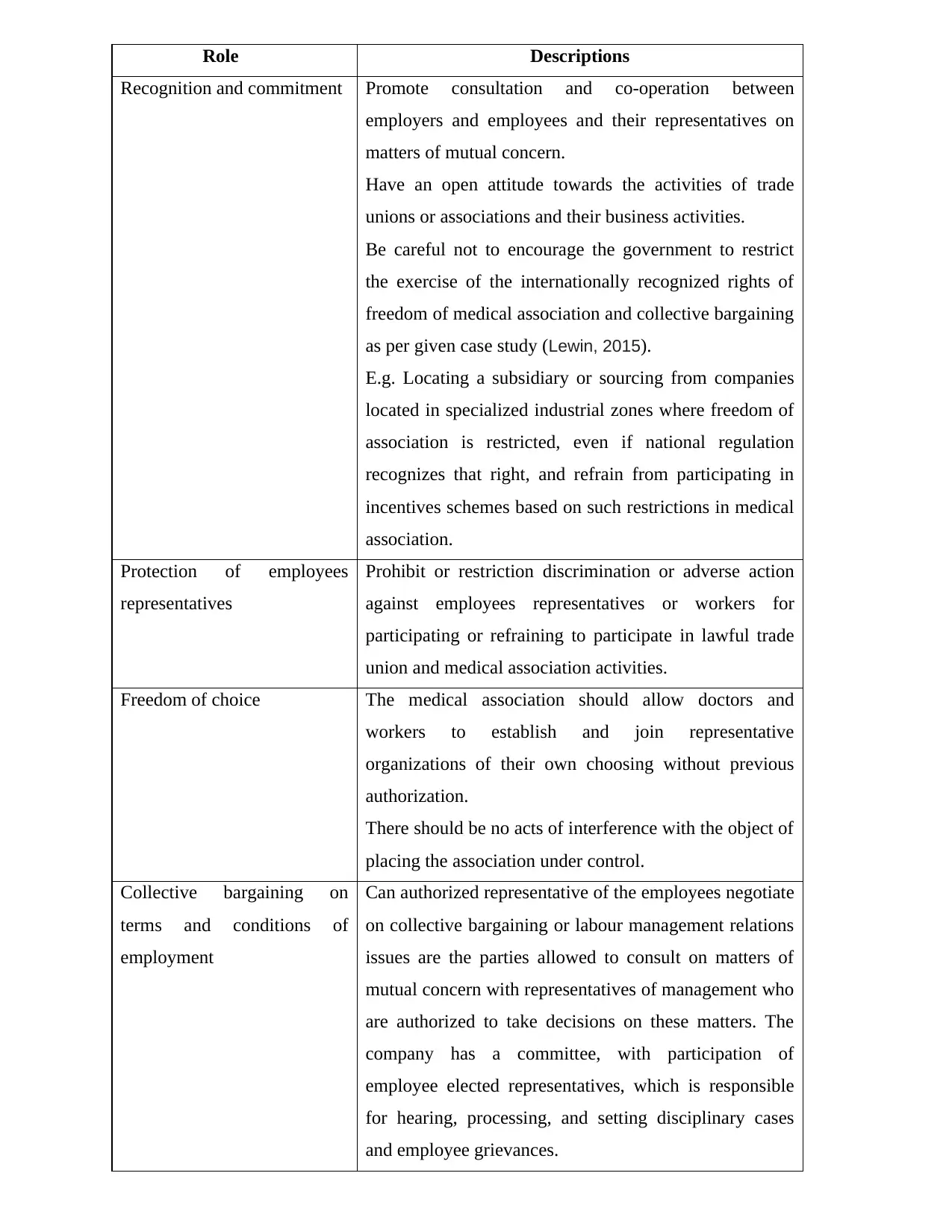
Role Descriptions
Recognition and commitment Promote consultation and co-operation between
employers and employees and their representatives on
matters of mutual concern.
Have an open attitude towards the activities of trade
unions or associations and their business activities.
Be careful not to encourage the government to restrict
the exercise of the internationally recognized rights of
freedom of medical association and collective bargaining
as per given case study (Lewin, 2015).
E.g. Locating a subsidiary or sourcing from companies
located in specialized industrial zones where freedom of
association is restricted, even if national regulation
recognizes that right, and refrain from participating in
incentives schemes based on such restrictions in medical
association.
Protection of employees
representatives
Prohibit or restriction discrimination or adverse action
against employees representatives or workers for
participating or refraining to participate in lawful trade
union and medical association activities.
Freedom of choice The medical association should allow doctors and
workers to establish and join representative
organizations of their own choosing without previous
authorization.
There should be no acts of interference with the object of
placing the association under control.
Collective bargaining on
terms and conditions of
employment
Can authorized representative of the employees negotiate
on collective bargaining or labour management relations
issues are the parties allowed to consult on matters of
mutual concern with representatives of management who
are authorized to take decisions on these matters. The
company has a committee, with participation of
employee elected representatives, which is responsible
for hearing, processing, and setting disciplinary cases
and employee grievances.
Recognition and commitment Promote consultation and co-operation between
employers and employees and their representatives on
matters of mutual concern.
Have an open attitude towards the activities of trade
unions or associations and their business activities.
Be careful not to encourage the government to restrict
the exercise of the internationally recognized rights of
freedom of medical association and collective bargaining
as per given case study (Lewin, 2015).
E.g. Locating a subsidiary or sourcing from companies
located in specialized industrial zones where freedom of
association is restricted, even if national regulation
recognizes that right, and refrain from participating in
incentives schemes based on such restrictions in medical
association.
Protection of employees
representatives
Prohibit or restriction discrimination or adverse action
against employees representatives or workers for
participating or refraining to participate in lawful trade
union and medical association activities.
Freedom of choice The medical association should allow doctors and
workers to establish and join representative
organizations of their own choosing without previous
authorization.
There should be no acts of interference with the object of
placing the association under control.
Collective bargaining on
terms and conditions of
employment
Can authorized representative of the employees negotiate
on collective bargaining or labour management relations
issues are the parties allowed to consult on matters of
mutual concern with representatives of management who
are authorized to take decisions on these matters. The
company has a committee, with participation of
employee elected representatives, which is responsible
for hearing, processing, and setting disciplinary cases
and employee grievances.
⊘ This is a preview!⊘
Do you want full access?
Subscribe today to unlock all pages.

Trusted by 1+ million students worldwide
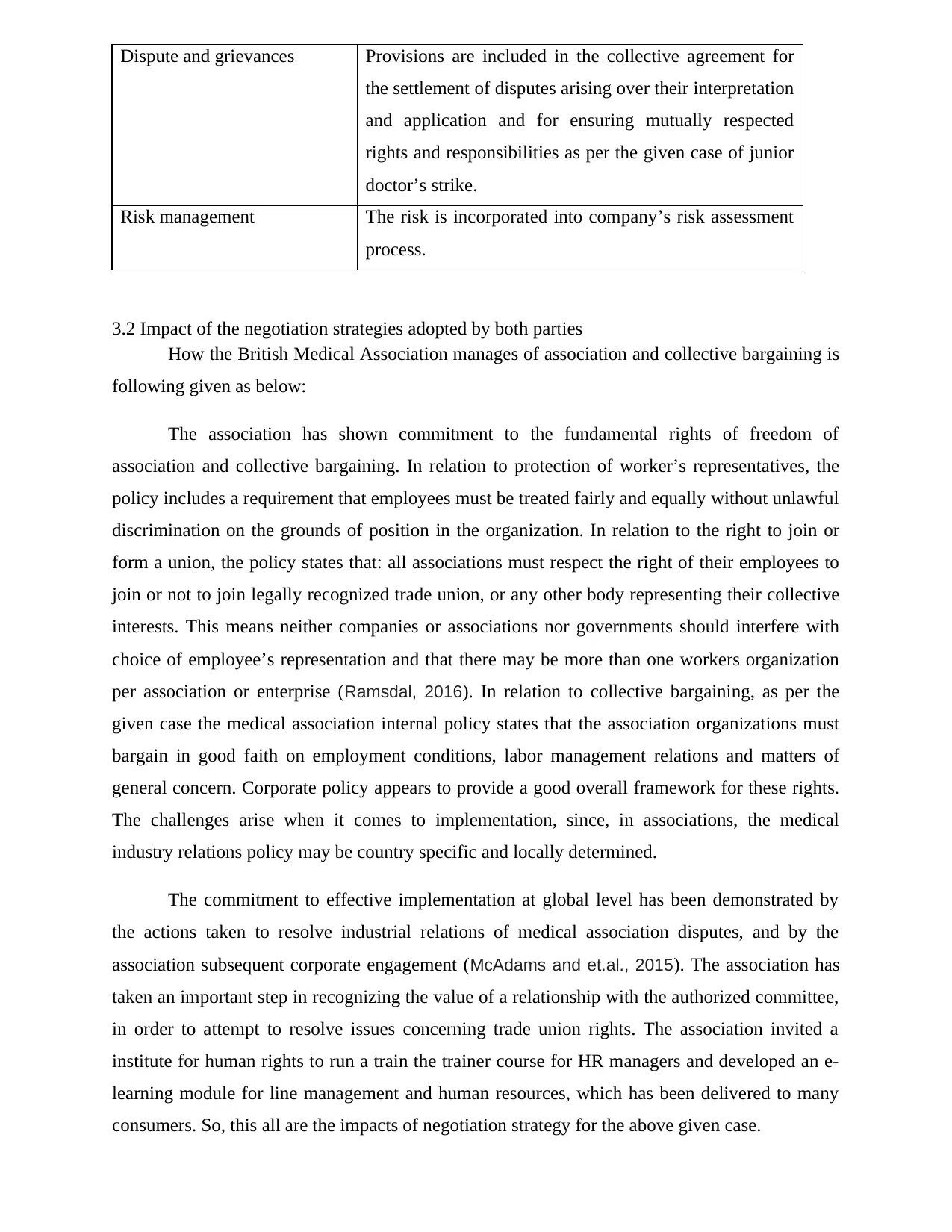
Dispute and grievances Provisions are included in the collective agreement for
the settlement of disputes arising over their interpretation
and application and for ensuring mutually respected
rights and responsibilities as per the given case of junior
doctor’s strike.
Risk management The risk is incorporated into company’s risk assessment
process.
3.2 Impact of the negotiation strategies adopted by both parties
How the British Medical Association manages of association and collective bargaining is
following given as below:
The association has shown commitment to the fundamental rights of freedom of
association and collective bargaining. In relation to protection of worker’s representatives, the
policy includes a requirement that employees must be treated fairly and equally without unlawful
discrimination on the grounds of position in the organization. In relation to the right to join or
form a union, the policy states that: all associations must respect the right of their employees to
join or not to join legally recognized trade union, or any other body representing their collective
interests. This means neither companies or associations nor governments should interfere with
choice of employee’s representation and that there may be more than one workers organization
per association or enterprise (Ramsdal, 2016). In relation to collective bargaining, as per the
given case the medical association internal policy states that the association organizations must
bargain in good faith on employment conditions, labor management relations and matters of
general concern. Corporate policy appears to provide a good overall framework for these rights.
The challenges arise when it comes to implementation, since, in associations, the medical
industry relations policy may be country specific and locally determined.
The commitment to effective implementation at global level has been demonstrated by
the actions taken to resolve industrial relations of medical association disputes, and by the
association subsequent corporate engagement (McAdams and et.al., 2015). The association has
taken an important step in recognizing the value of a relationship with the authorized committee,
in order to attempt to resolve issues concerning trade union rights. The association invited a
institute for human rights to run a train the trainer course for HR managers and developed an e-
learning module for line management and human resources, which has been delivered to many
consumers. So, this all are the impacts of negotiation strategy for the above given case.
the settlement of disputes arising over their interpretation
and application and for ensuring mutually respected
rights and responsibilities as per the given case of junior
doctor’s strike.
Risk management The risk is incorporated into company’s risk assessment
process.
3.2 Impact of the negotiation strategies adopted by both parties
How the British Medical Association manages of association and collective bargaining is
following given as below:
The association has shown commitment to the fundamental rights of freedom of
association and collective bargaining. In relation to protection of worker’s representatives, the
policy includes a requirement that employees must be treated fairly and equally without unlawful
discrimination on the grounds of position in the organization. In relation to the right to join or
form a union, the policy states that: all associations must respect the right of their employees to
join or not to join legally recognized trade union, or any other body representing their collective
interests. This means neither companies or associations nor governments should interfere with
choice of employee’s representation and that there may be more than one workers organization
per association or enterprise (Ramsdal, 2016). In relation to collective bargaining, as per the
given case the medical association internal policy states that the association organizations must
bargain in good faith on employment conditions, labor management relations and matters of
general concern. Corporate policy appears to provide a good overall framework for these rights.
The challenges arise when it comes to implementation, since, in associations, the medical
industry relations policy may be country specific and locally determined.
The commitment to effective implementation at global level has been demonstrated by
the actions taken to resolve industrial relations of medical association disputes, and by the
association subsequent corporate engagement (McAdams and et.al., 2015). The association has
taken an important step in recognizing the value of a relationship with the authorized committee,
in order to attempt to resolve issues concerning trade union rights. The association invited a
institute for human rights to run a train the trainer course for HR managers and developed an e-
learning module for line management and human resources, which has been delivered to many
consumers. So, this all are the impacts of negotiation strategy for the above given case.
Paraphrase This Document
Need a fresh take? Get an instant paraphrase of this document with our AI Paraphraser
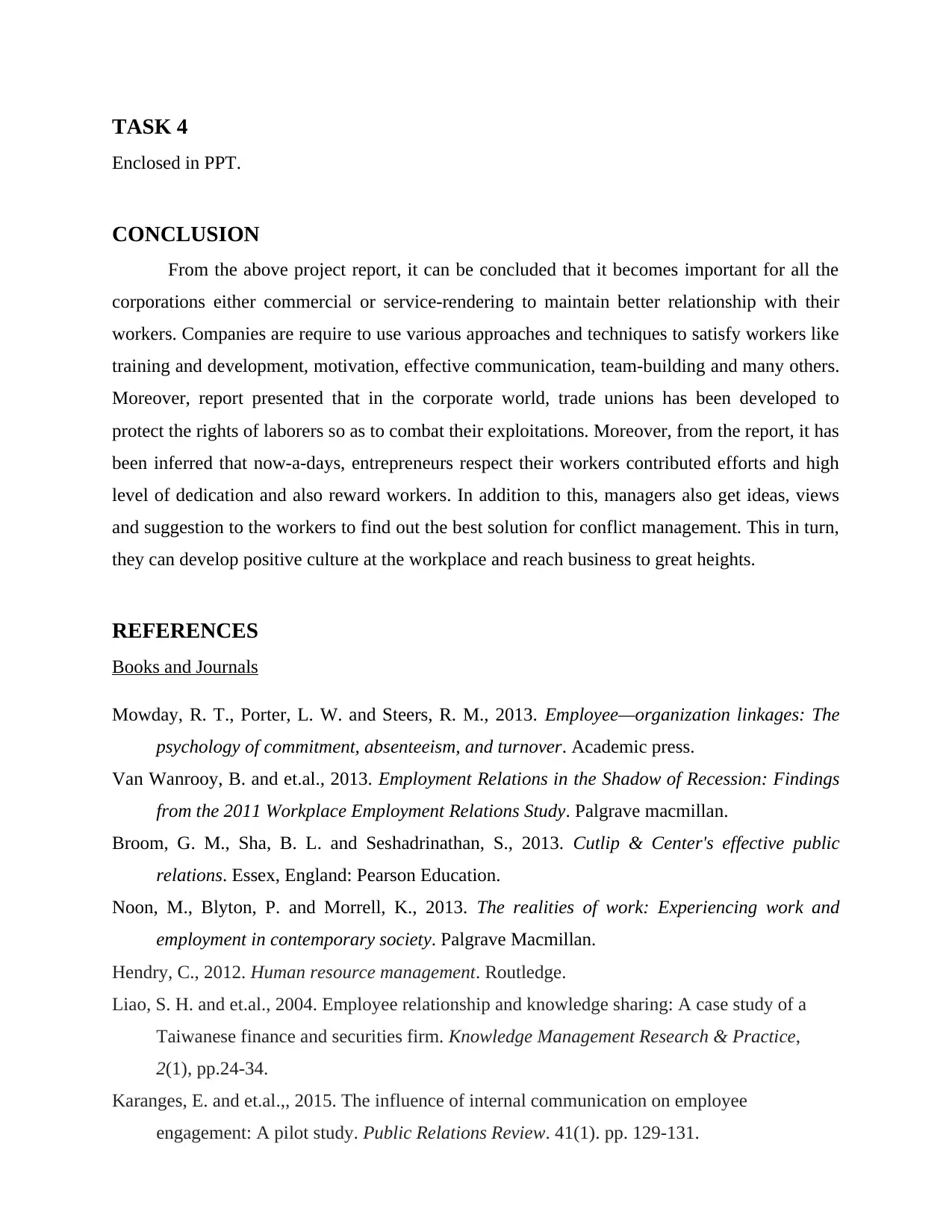
TASK 4
Enclosed in PPT.
CONCLUSION
From the above project report, it can be concluded that it becomes important for all the
corporations either commercial or service-rendering to maintain better relationship with their
workers. Companies are require to use various approaches and techniques to satisfy workers like
training and development, motivation, effective communication, team-building and many others.
Moreover, report presented that in the corporate world, trade unions has been developed to
protect the rights of laborers so as to combat their exploitations. Moreover, from the report, it has
been inferred that now-a-days, entrepreneurs respect their workers contributed efforts and high
level of dedication and also reward workers. In addition to this, managers also get ideas, views
and suggestion to the workers to find out the best solution for conflict management. This in turn,
they can develop positive culture at the workplace and reach business to great heights.
REFERENCES
Books and Journals
Mowday, R. T., Porter, L. W. and Steers, R. M., 2013. Employee—organization linkages: The
psychology of commitment, absenteeism, and turnover. Academic press.
Van Wanrooy, B. and et.al., 2013. Employment Relations in the Shadow of Recession: Findings
from the 2011 Workplace Employment Relations Study. Palgrave macmillan.
Broom, G. M., Sha, B. L. and Seshadrinathan, S., 2013. Cutlip & Center's effective public
relations. Essex, England: Pearson Education.
Noon, M., Blyton, P. and Morrell, K., 2013. The realities of work: Experiencing work and
employment in contemporary society. Palgrave Macmillan.
Hendry, C., 2012. Human resource management. Routledge.
Liao, S. H. and et.al., 2004. Employee relationship and knowledge sharing: A case study of a
Taiwanese finance and securities firm. Knowledge Management Research & Practice,
2(1), pp.24-34.
Karanges, E. and et.al.,, 2015. The influence of internal communication on employee
engagement: A pilot study. Public Relations Review. 41(1). pp. 129-131.
Enclosed in PPT.
CONCLUSION
From the above project report, it can be concluded that it becomes important for all the
corporations either commercial or service-rendering to maintain better relationship with their
workers. Companies are require to use various approaches and techniques to satisfy workers like
training and development, motivation, effective communication, team-building and many others.
Moreover, report presented that in the corporate world, trade unions has been developed to
protect the rights of laborers so as to combat their exploitations. Moreover, from the report, it has
been inferred that now-a-days, entrepreneurs respect their workers contributed efforts and high
level of dedication and also reward workers. In addition to this, managers also get ideas, views
and suggestion to the workers to find out the best solution for conflict management. This in turn,
they can develop positive culture at the workplace and reach business to great heights.
REFERENCES
Books and Journals
Mowday, R. T., Porter, L. W. and Steers, R. M., 2013. Employee—organization linkages: The
psychology of commitment, absenteeism, and turnover. Academic press.
Van Wanrooy, B. and et.al., 2013. Employment Relations in the Shadow of Recession: Findings
from the 2011 Workplace Employment Relations Study. Palgrave macmillan.
Broom, G. M., Sha, B. L. and Seshadrinathan, S., 2013. Cutlip & Center's effective public
relations. Essex, England: Pearson Education.
Noon, M., Blyton, P. and Morrell, K., 2013. The realities of work: Experiencing work and
employment in contemporary society. Palgrave Macmillan.
Hendry, C., 2012. Human resource management. Routledge.
Liao, S. H. and et.al., 2004. Employee relationship and knowledge sharing: A case study of a
Taiwanese finance and securities firm. Knowledge Management Research & Practice,
2(1), pp.24-34.
Karanges, E. and et.al.,, 2015. The influence of internal communication on employee
engagement: A pilot study. Public Relations Review. 41(1). pp. 129-131.
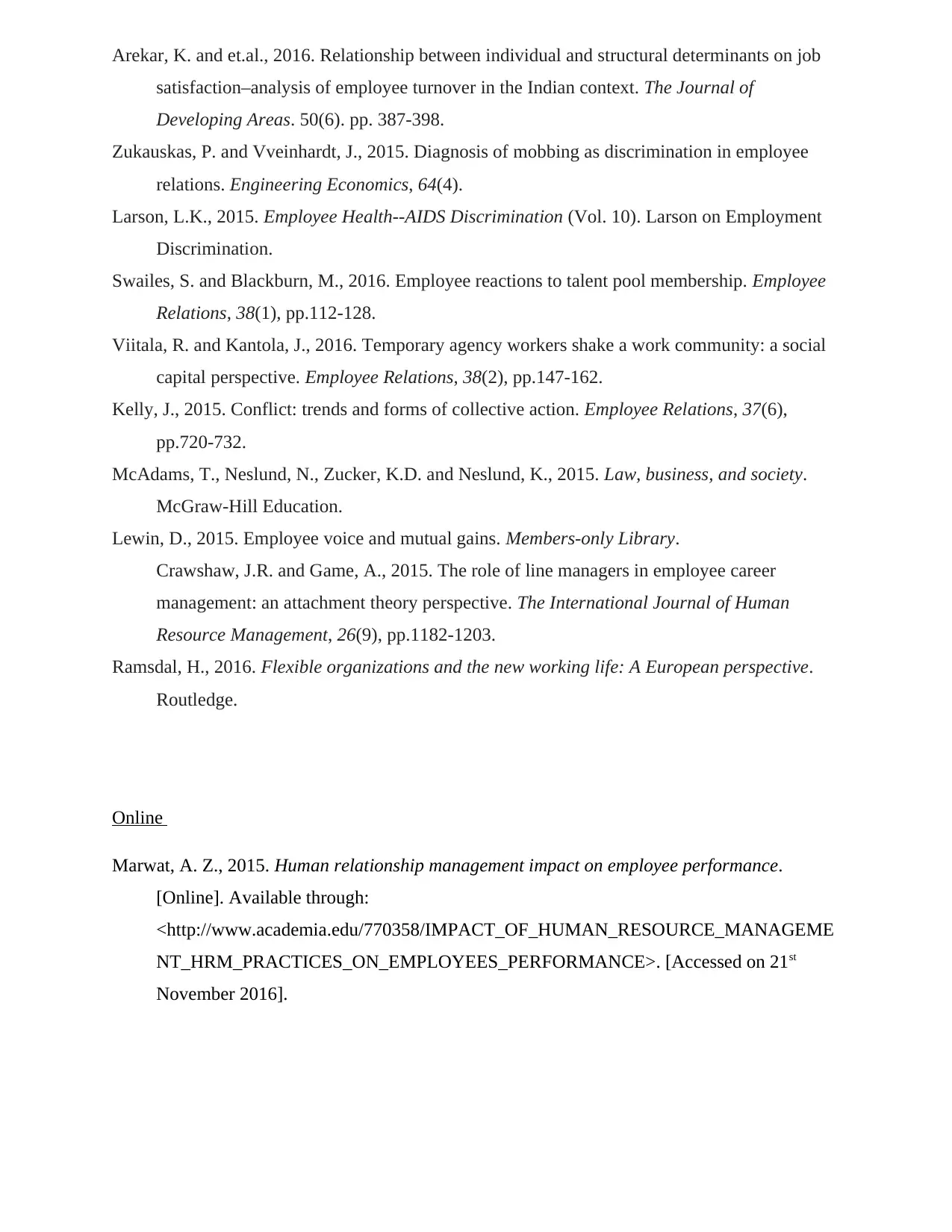
Arekar, K. and et.al., 2016. Relationship between individual and structural determinants on job
satisfaction–analysis of employee turnover in the Indian context. The Journal of
Developing Areas. 50(6). pp. 387-398.
Zukauskas, P. and Vveinhardt, J., 2015. Diagnosis of mobbing as discrimination in employee
relations. Engineering Economics, 64(4).
Larson, L.K., 2015. Employee Health--AIDS Discrimination (Vol. 10). Larson on Employment
Discrimination.
Swailes, S. and Blackburn, M., 2016. Employee reactions to talent pool membership. Employee
Relations, 38(1), pp.112-128.
Viitala, R. and Kantola, J., 2016. Temporary agency workers shake a work community: a social
capital perspective. Employee Relations, 38(2), pp.147-162.
Kelly, J., 2015. Conflict: trends and forms of collective action. Employee Relations, 37(6),
pp.720-732.
McAdams, T., Neslund, N., Zucker, K.D. and Neslund, K., 2015. Law, business, and society.
McGraw-Hill Education.
Lewin, D., 2015. Employee voice and mutual gains. Members-only Library.
Crawshaw, J.R. and Game, A., 2015. The role of line managers in employee career
management: an attachment theory perspective. The International Journal of Human
Resource Management, 26(9), pp.1182-1203.
Ramsdal, H., 2016. Flexible organizations and the new working life: A European perspective.
Routledge.
Online
Marwat, A. Z., 2015. Human relationship management impact on employee performance.
[Online]. Available through:
<http://www.academia.edu/770358/IMPACT_OF_HUMAN_RESOURCE_MANAGEME
NT_HRM_PRACTICES_ON_EMPLOYEES_PERFORMANCE>. [Accessed on 21st
November 2016].
satisfaction–analysis of employee turnover in the Indian context. The Journal of
Developing Areas. 50(6). pp. 387-398.
Zukauskas, P. and Vveinhardt, J., 2015. Diagnosis of mobbing as discrimination in employee
relations. Engineering Economics, 64(4).
Larson, L.K., 2015. Employee Health--AIDS Discrimination (Vol. 10). Larson on Employment
Discrimination.
Swailes, S. and Blackburn, M., 2016. Employee reactions to talent pool membership. Employee
Relations, 38(1), pp.112-128.
Viitala, R. and Kantola, J., 2016. Temporary agency workers shake a work community: a social
capital perspective. Employee Relations, 38(2), pp.147-162.
Kelly, J., 2015. Conflict: trends and forms of collective action. Employee Relations, 37(6),
pp.720-732.
McAdams, T., Neslund, N., Zucker, K.D. and Neslund, K., 2015. Law, business, and society.
McGraw-Hill Education.
Lewin, D., 2015. Employee voice and mutual gains. Members-only Library.
Crawshaw, J.R. and Game, A., 2015. The role of line managers in employee career
management: an attachment theory perspective. The International Journal of Human
Resource Management, 26(9), pp.1182-1203.
Ramsdal, H., 2016. Flexible organizations and the new working life: A European perspective.
Routledge.
Online
Marwat, A. Z., 2015. Human relationship management impact on employee performance.
[Online]. Available through:
<http://www.academia.edu/770358/IMPACT_OF_HUMAN_RESOURCE_MANAGEME
NT_HRM_PRACTICES_ON_EMPLOYEES_PERFORMANCE>. [Accessed on 21st
November 2016].
⊘ This is a preview!⊘
Do you want full access?
Subscribe today to unlock all pages.

Trusted by 1+ million students worldwide
1 out of 12
Related Documents
Your All-in-One AI-Powered Toolkit for Academic Success.
+13062052269
info@desklib.com
Available 24*7 on WhatsApp / Email
![[object Object]](/_next/static/media/star-bottom.7253800d.svg)
Unlock your academic potential
Copyright © 2020–2025 A2Z Services. All Rights Reserved. Developed and managed by ZUCOL.





